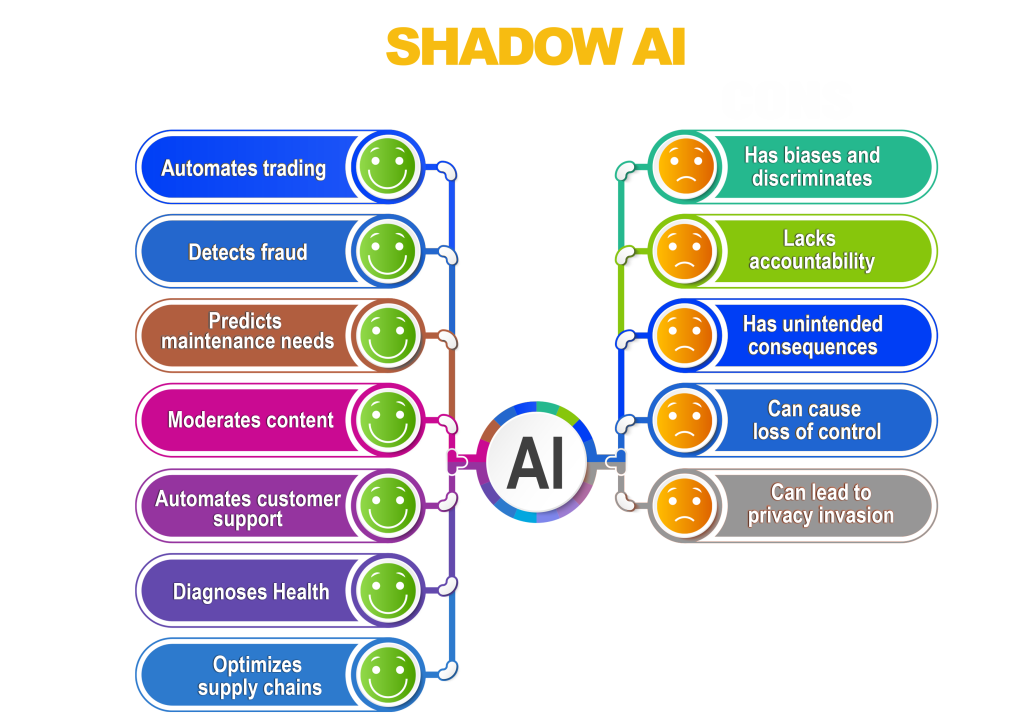A Deep Dive into Shadow AI and Its Impact on Organizational Dynamics
In today’s rapidly evolving technological landscape, a new and crucial topic has emerged: the rise of shadow AI. As organizations dive deeper into the era of artificial intelligence, they face a growing challenge akin to the shadow IT phenomenon—AI solutions that operate outside the official purview or control of the IT department. With the widespread deployment of AI, managing and securing these unsanctioned solutions has become a significant concern for organizations.
The increased accessibility of AI is both a blessing and a challenge. On the one hand, it empowers individuals and teams to leverage AI for their specific needs, but on the other hand, it leads to the proliferation of shadow AI—AI solutions that operate beyond the traditional boundaries of IT oversight.
A key factor contributing to the rise of shadow AI is the lack of a unified approach to AI solutions within many organizations. Instead of implementing cohesive strategies, individual teams often develop and deploy AI independently, resulting in disconnected solutions that operate in isolation from IT and other critical departments. This fragmentation creates an environment ripe for shadow AI to thrive.
The Pros and Cons of Shadow AI
Shadow AI, while often viewed with concern, is not inherently harmful. In fact, it can be a powerful tool for organizations to harness the productivity and efficiency that AI offers. By giving individuals and teams the freedom to develop AI solutions tailored to their specific tasks, shadow AI fosters innovation and leads to more effective and productive teams. This autonomy can also enhance employee morale and engagement, as team members feel more empowered to contribute directly to the organization’s success.
However, the rise of shadow AI also brings significant challenges. AI solutions that operate outside IT’s jurisdiction are difficult to monitor and control, which can lead to inadequate security measures and improper use of technology. Additionally, when AI solutions are siloed within different parts of an organization, sharing data and information becomes a complex and challenging task. While shadow AI itself isn’t negative, it highlights the need for effective AI management to address the risks associated with its unregulated use.
Managing Shadow AI: Key Considerations
The future of education will be shaped by AI, offering personalized learning experiences tailored to individual student needs and learning styles. Over the next decade, AI-powered adaptive learning platforms, virtual tutors, and immersive educational experiences will revolutionize how knowledge is acquired and disseminated.
To navigate the complexities of shadow AI, organizations must implement several critical strategies:
Access Control: It’s essential for organizations to oversee who has access to AI solutions, including both models and data. A crucial part of access control is the ability to revoke access quickly, particularly in scenarios like an employee leaving the organization.
Monitoring: Organizations need to monitor the usage of all AI solutions. This monitoring is vital not only for assessing the effectiveness of these solutions but also for ensuring they are being used appropriately and securely.
Deployment: Efficient management of AI solution deployment, including updates, is key. A robust deployment strategy helps trace AI solutions back to their development processes, ensuring consistency and reliability.
Security: Security remains a paramount concern in AI management.

Organizations must be able to enforce strong security controls to protect against potential attacks or data breaches.
Shadow AI presents a paradox for organizations: it fosters innovation and creativity but also raises concerns about security, communication, monitoring, deployment, and scalability. As we explore the intricate world of shadow AI, it’s evident that while it offers significant opportunities, it also demands careful management. In the age of artificial intelligence, organizations must strike a balance between encouraging innovation and maintaining control to successfully navigate the challenges and opportunities that shadow AI presents.
Join us in exploring the boundless potential of this convergence and together shaping the future of AI in the upcoming decade.
And if you found this blog helpful, don’t forget to share our page to your friends and family for more insightful content on Artificial Intelligence. Share our latest updates and tips. Thank you for being a part of our community!
For further assistance, visit our channel and refer the video .
Future of AI | AI in next 10 years | Futuristic AI: Turilytix BIG-AI

Share This :


Thank you, your article surprised me, there is such an excellent point of view. Thank you for sharing, I learned a lot.